Forum Replies Created
-
AuthorReplies
-
January 31, 2018 at 12:36 pm in reply to: Motor Restrictions & ‘Slow’ Motor Classes for Scratch32 #5563
But first, why not reward those who have scratch32 accounts and regularly visit and contribute to this site? Since almost everyone who races with scratch32 also races in another group, whether it is R32 or another group in southern Ontario – the Vanski motor is still widely sought after. So for anyone who is a scratch32 member (with an account that can reply to this thread) I’ll release 2 brand new Vanski motors for $20 ($10 each). First person to deliver cash in hand will get them… no paypal and no pre-orders. :good:
The Happy Canadian Scale Modeler!
Looks good DB! :yahoo:
The Happy Canadian Scale Modeler!
January 22, 2018 at 9:58 am in reply to: Building in Upper and lower A arms and rear and front springs etc #5432Basically I cut the brass tube into appropriate pieces and built up each component by simply fitting one inside the other. To cut this stuff cleanly you could use the lathe but I just used my drill and dremel to show that it can be done by hand that way for those who don’t have a lathe. If you place a scrap piece of rod or wire inside each tube (in the drill) before cutting it makes the job much easier – especially to cut very narrow pieces like the rings that will hold the coil in place. Make sure to clean up each piece after it is cut with some fine sandpaper (wet or dry).
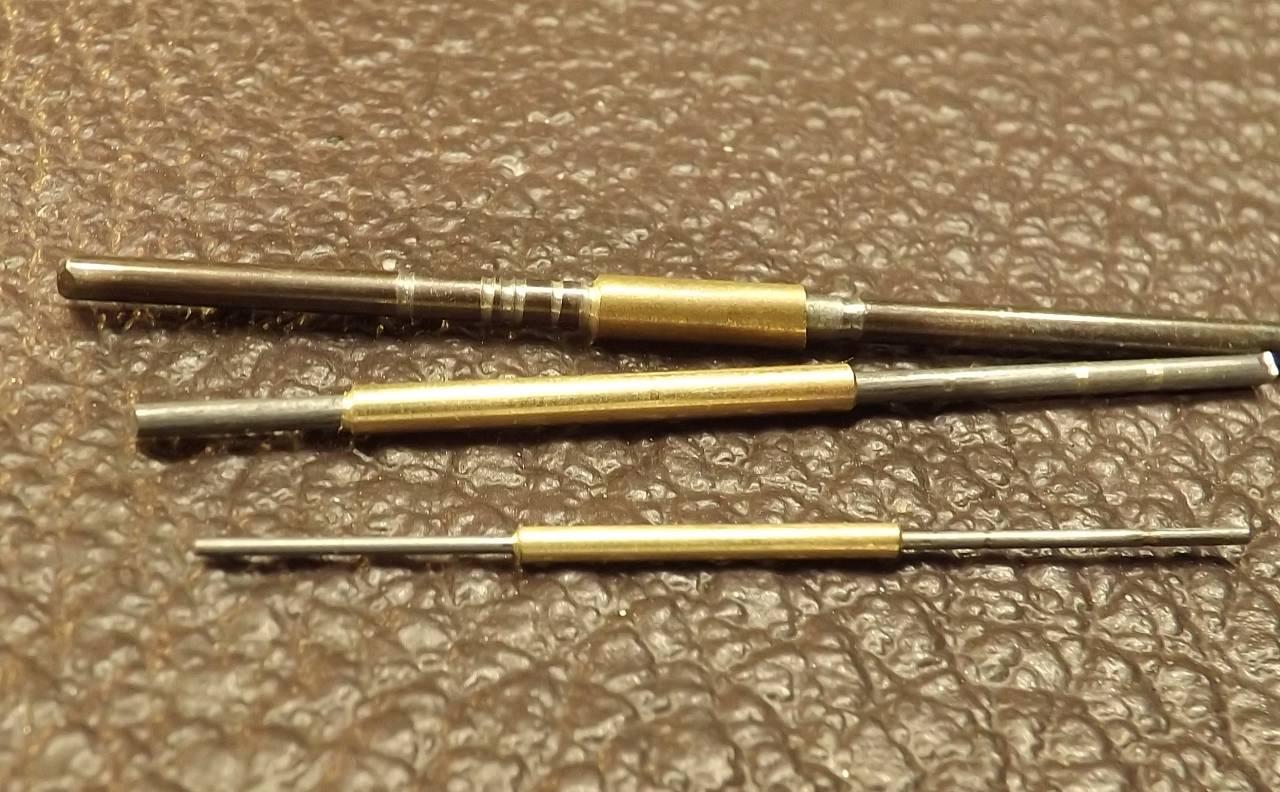
As you can see in the picture below each shock/coil assembly has four parts: upper & lower shock, shock arm & coil (these are not the terms a mechanic would use since I don’t know what they are called but you should get the picture). The arm has a small piece of 1/16″ brass tube soldered to it. All of the parts pictured below were soldered together – for some I used a jig since they are just too small to do without.
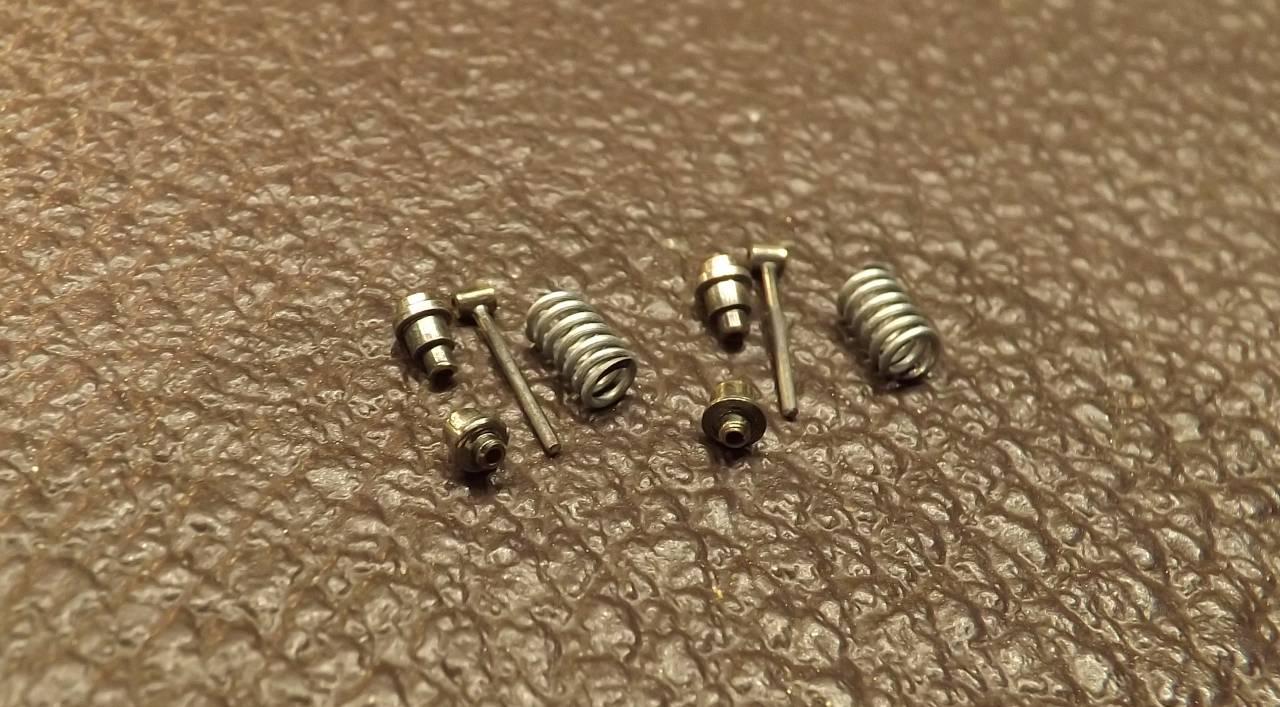 In total each shock/coil piece is comprised of 9 separate parts and are now ready for paint. These parts do not need to be soldered when assembling. Each shock/coil when complete can be mounted at the top by a rod through the 1/16″ piece of tube we soldered to the top of the arm, and at the bottom by fitting the bottom of the arm inside a small 1/16″ piece of tube (or wire circle). On to paint…
In total each shock/coil piece is comprised of 9 separate parts and are now ready for paint. These parts do not need to be soldered when assembling. Each shock/coil when complete can be mounted at the top by a rod through the 1/16″ piece of tube we soldered to the top of the arm, and at the bottom by fitting the bottom of the arm inside a small 1/16″ piece of tube (or wire circle). On to paint…The Happy Canadian Scale Modeler!
January 21, 2018 at 1:09 pm in reply to: Building in Upper and lower A arms and rear and front springs etc #5431Well, it might be time to tackle this topic.
Building Your Suspension (Part I) – Springs/Coils & Shock Absorber Assembly
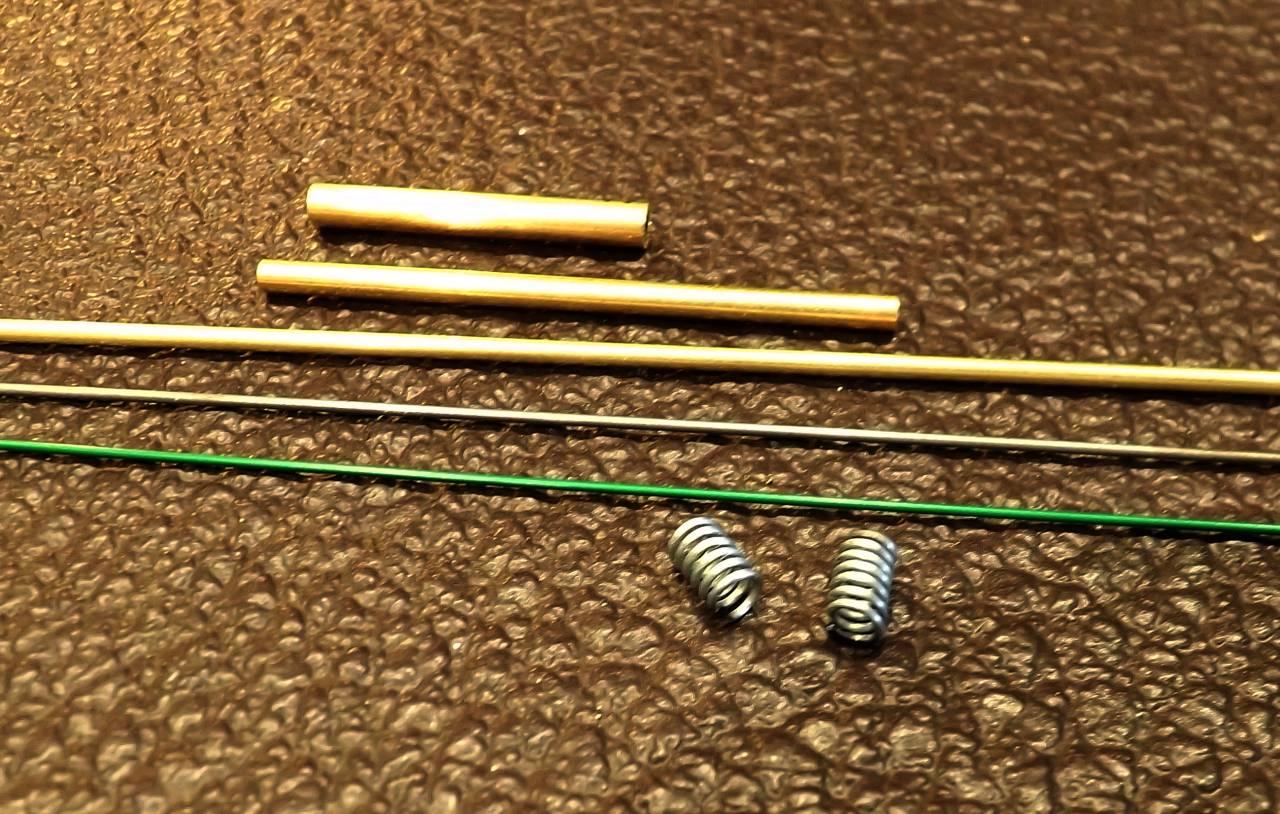
Parts needed to make a variety of sizes of 1/32 springs/coils & shock absorbers:
- K&S 1/16″ brass tube;
- K&S 3/32″ brass tube;
- K&S 1/8″ brass tube;
- K&S .032″ piano wire (to fit inside the 1/16″ brass tube);
- .020″ (or comparable sized) soft wire (I found some very flexible steel wire at a local dollar store used for flower arrangements – strip the green plastic coating from the wire).
Any of the above items can be substituted with another product but these are what I used. I am far from a rivet counter so as long as something looks right then in my opinion it works. If anyone is concerned with exact scale, lengths or widths then what I’ve done can be adjusted to meet those criteria. It all boils down to one’s ability and expectations.
I will make the front springs/coils & shock absorbers for a Shadow DN1 since that is the model I’m completing – the DArt Eclektrix Quick Kit from darthobbies – a repop of the original Scaley release with some added parts. This car had some beefy but short front coils & shock absorbers.
I wound the .020″ wire around a 3/32 brass tube to create each spring/coil for this application. For most other applications you would use the 1/16 brass tube (or piano wire). How you wind it is up to you – I wound mine tightly and then just pulled it apart slightly. When working with small bits like this don’t forget to leave a liberal amount of excess for handling which will be cut or removed later – a little wasteful but it makes the task much easier (For each spring I used about 12 cm of wire which I could wind around my finger to coil it tightly – you could wind a long strand and then cut each one off if you are on a roll to save material… your choice). This is a great task to do while watching TV…
After making sure I was happy with the look of both springs/coils I cut the excess off using my dremel cutting disk. Using the same tool I then ground down both ends to make the spring/coil flatter so that each spring could sit upright on a flat surface (on both ends). Since the spring/coil will not be soldered or glued to anything we are done with them for now.
(stay tuned for more…)
The Happy Canadian Scale Modeler!
Driver’s stand completed:
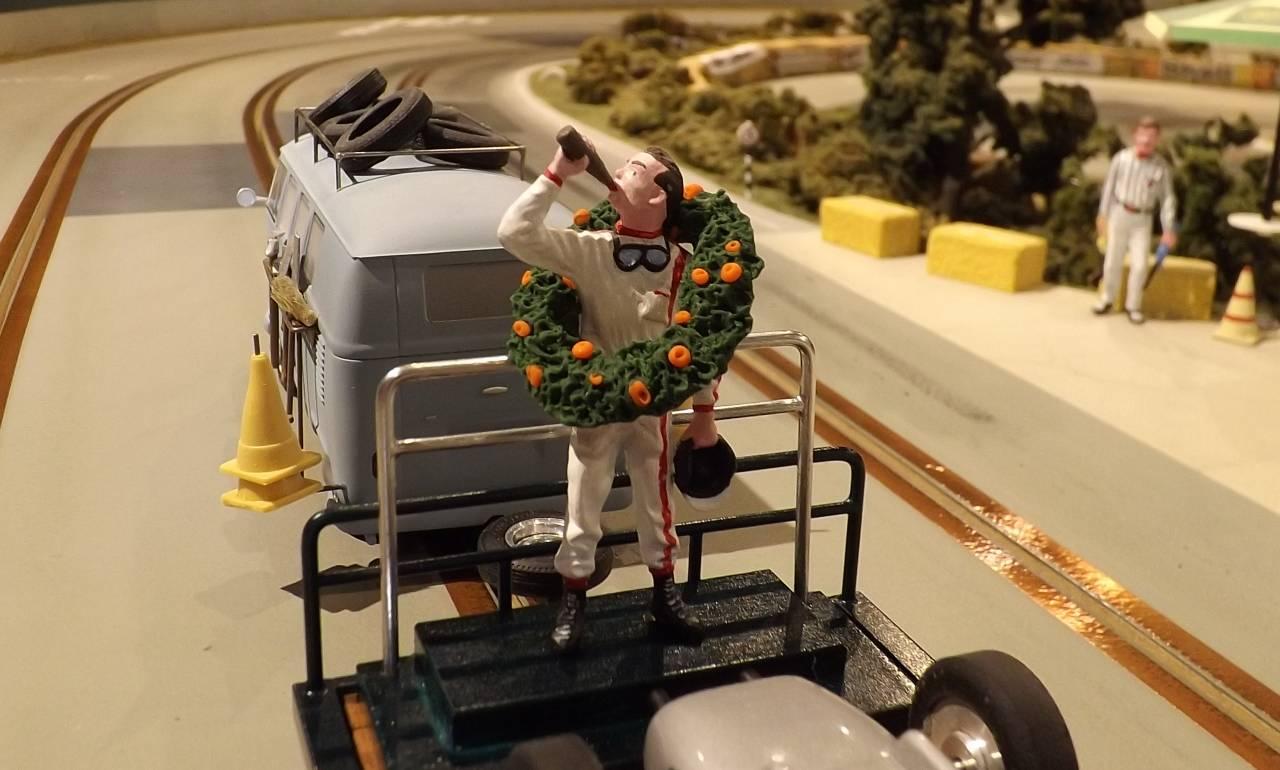
A shot of the loaded trailer using the drop down 5th wheel:
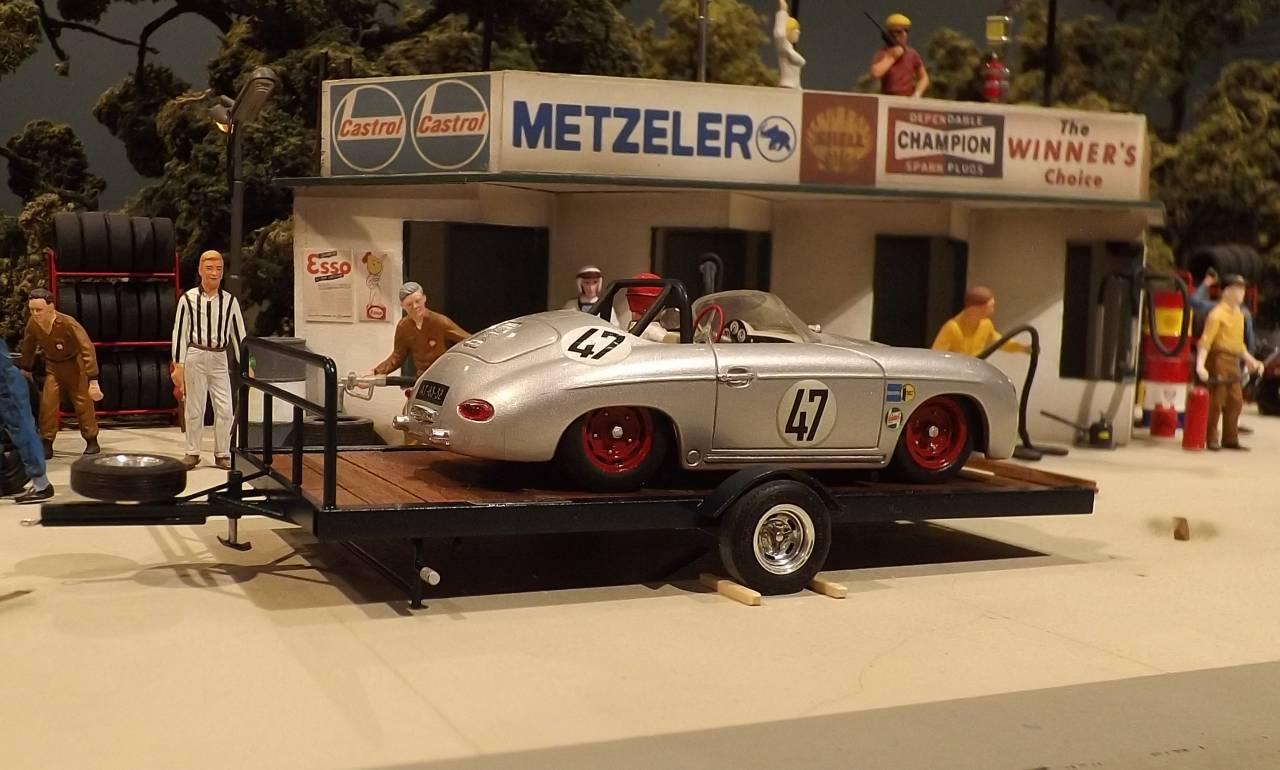
The Happy Canadian Scale Modeler!
If someone has a model kit with vintage cab like this one (complete with windscreen & detailed bits) I think I can fabricate the back half…
The Happy Canadian Scale Modeler!
Here’s a little video:
The Happy Canadian Scale Modeler!
January 19, 2018 at 5:48 am in reply to: Building in Upper and lower A arms and rear and front springs etc #5411Haven’t forgotten – still working on it…
The Happy Canadian Scale Modeler!
That’s a fabulous story in B&W! Great sleuthing F1nutz! Thanks for sharing it here! I’ll be keeping my eye out for one of those north American styled transporters too… 😉
The Happy Canadian Scale Modeler!
Cheers MiA! This duo will do a sub 12 second lap without a load… not that this is relevant… surprisingly the BWMS050 motored VW can haul the 2J with little trouble… this duo will debut at Ringwood XXIV and run a lap after each race… I’ve even got victory wreaths prepared for the winning pilot during his victory lap… stay tuned for that!
The Happy Canadian Scale Modeler!
The same chassis from the top.
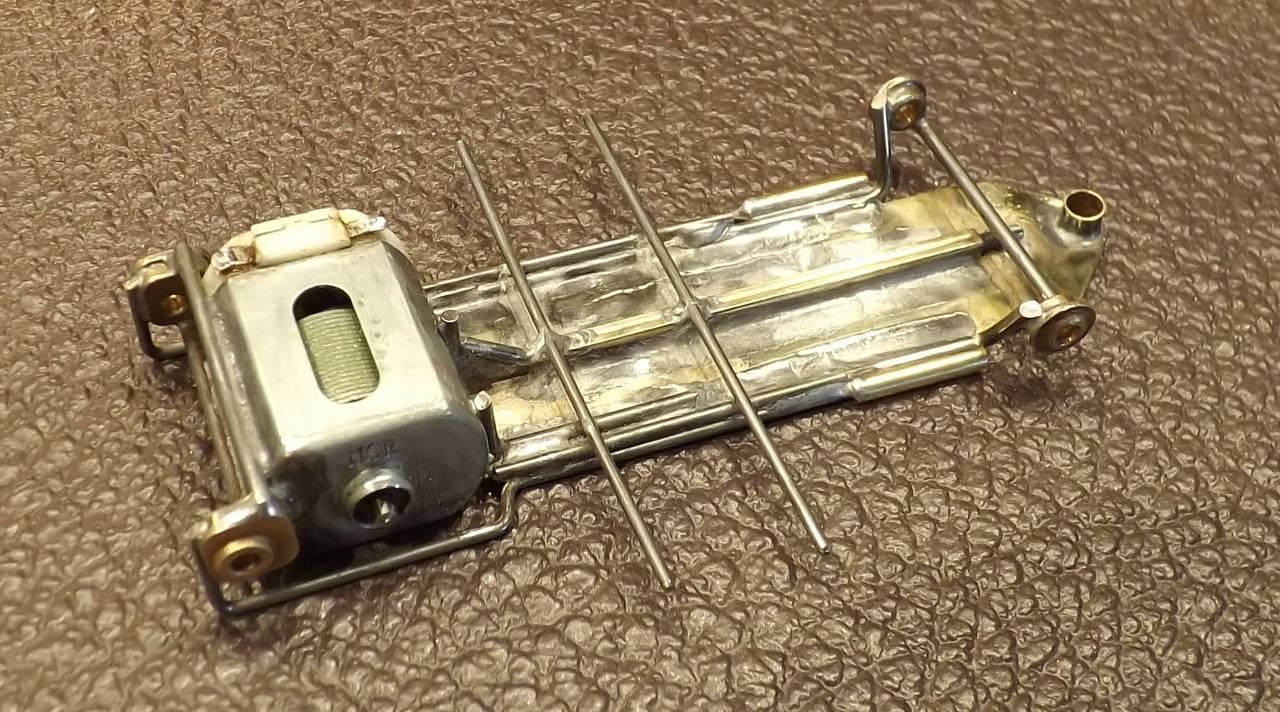
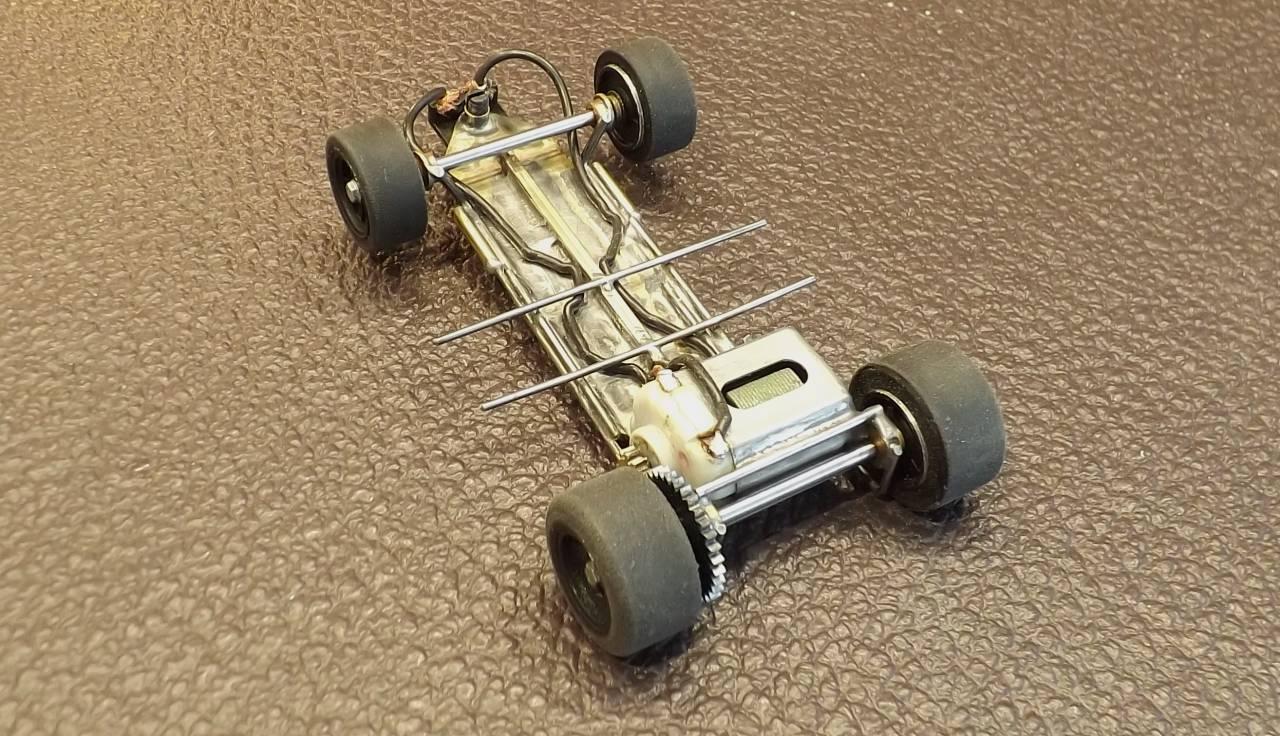 This was originally a torsion chassis that I later froze with added wire & bracing. The result (with side plates & body) was 3/10 faster than the original design – clocking 5.807 in Targa III. It isn’t pretty but it is whisper quiet and corners on rails. Brass for the tongue is .o30″ stock. :unsure:
This was originally a torsion chassis that I later froze with added wire & bracing. The result (with side plates & body) was 3/10 faster than the original design – clocking 5.807 in Targa III. It isn’t pretty but it is whisper quiet and corners on rails. Brass for the tongue is .o30″ stock. :unsure:The Happy Canadian Scale Modeler!
Here is a typical tongue/chassis that I use – this one happens to be from the 908/3 which recently raced in the Targa III – over rotation results in a gentle deslot. This one was fabricated to accommodate a slot.it guide and note the 45-50 degree rake as mentioned above.
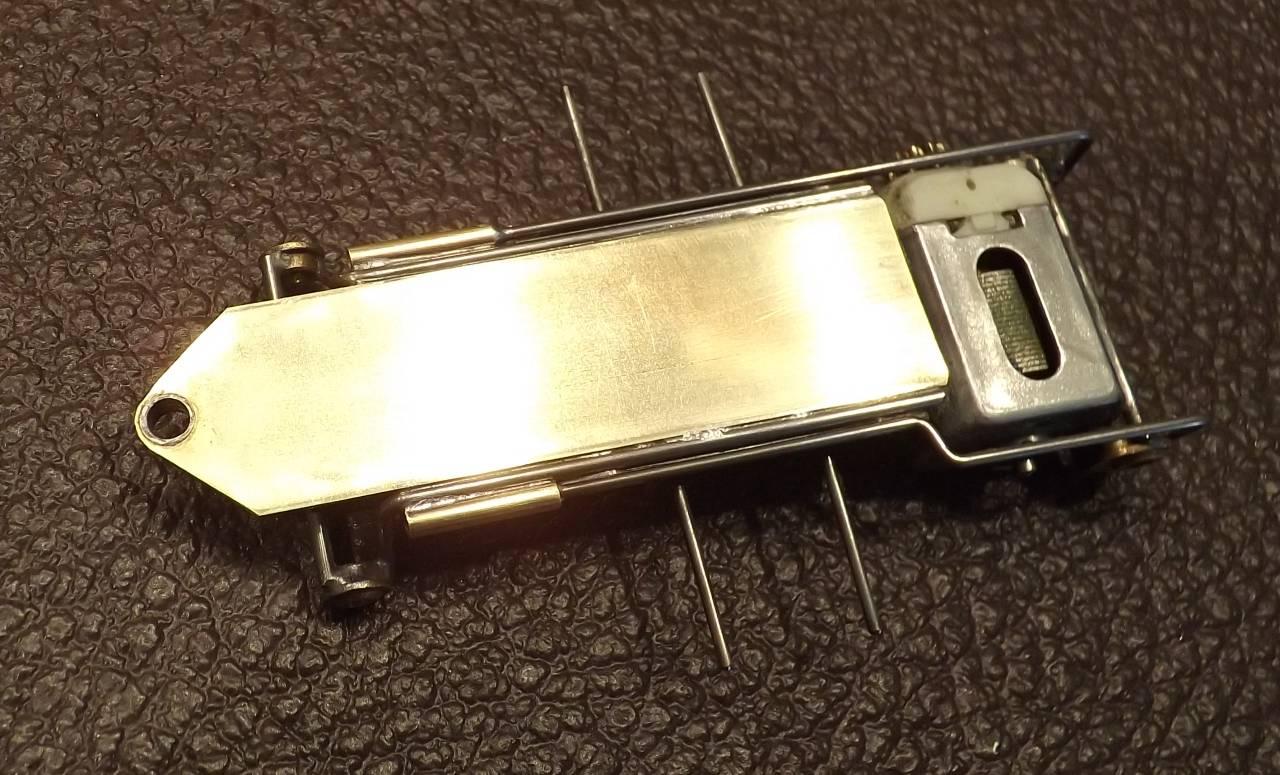
The Happy Canadian Scale Modeler!
I have seen many Fly Chevrons and the only noticeable difference between their models is the cockpit opening/windscreen/mirror configuration – and although they modeled the B23 there is no difference from the B21 body… thanks for posting the topic and the addition! :good:
The Happy Canadian Scale Modeler!
December 21, 2017 at 8:50 am in reply to: Filler – Caution Using Plastic Cement & Styrene Mixture… #5188I completely agree Bill. One product I use especially if the model will be subject to pressure (ie. a prototype) is JB weld. Although it adds weight it does not collapse under pressure. Combined with styrene panels it can work well – and is easily painted. I’ve used this method on the Autobianchi(sp) I am making from a modified Honda ARII kit. Hopefully it will get to finally debut at the Targa III.
The Happy Canadian Scale Modeler!
Great explanations! Thanks MiA! :wacko:
The Happy Canadian Scale Modeler!
This is a great idea! Go Bill Go! :yahoo: I love the construction – what a beautiful and sleek looking frame!
The Happy Canadian Scale Modeler!
Well, its been a few months now and so time to get off the pot. I polished away all of the ‘vinegar’ marks that appeared around some of the decals where we used extra Micro Set to get them to lie flat with Tamiya polish… When the paint finally looked clean I got the remaining dust off – I used my compressor with a fine nozzle to spray any dust away. I then left the body hanging upside down in my paint booth while I prepared the can of Tamiya TS-13 – A perfect match for the base coat of green. Obviously you need to have something mounted to a body post or glued to the underside of the body – like a styrene tube or a stick with clamps… I heated up the can/paint in a sink using the hottest water from my tap – I let the can sit in the centre of the drain to block/slow the water flow. After the water reached half way up the can I turned off the tap and let the water drain slowly until it was gone. I left the cap on the can throughout. I got a small towel, and after the hot water drained I took the can out and wrapped it in the towel and shook it all about for 5 minutes or so. I immediately sprayed the body with one quick coat everywhere. After 3 minutes I sprayed a slightly heavier coat everywhere again. I then took the body to a warm lamp where it could dry upside down while hanging from a hook. I couldn’t have asked for a better result – all of our home made decals were perfect – and now everything was sealed permanently – and shiny.
This will be one of the shells used in our detailing session on Monday. I have a McLaren M12 with a Castrol livery which we will also use time permitting.
The Happy Canadian Scale Modeler!
What a great short film! Lots of goodies to snag from it too like track, car and helmet/goggle/glove details…. Wunderbar! :good:
The Happy Canadian Scale Modeler!
Along with ‘race to line’ SlotTrak introduced a new feature: ‘hot starts’. Race to line was somewhat revolutionary because for once timed heats could be recorded accurately by the computer without manual intervention thereby avoiding mistakes [or dare we say it cheating] (unlike the old school timing method noted above). Just ‘set it and forget it’ was finally possible for timed racing with the computer controlling the pace of the entire race evening. Furthermore, race to line avoided the situation where everyone was forced to wait until the last car completed the same number of laps – which could take an unbearably long time for longer heats not to mention cause considerable embarrassment for the lagging pilot. Could you imagine racing the 2.4h and using that method? It would add several hours to the event…
Other benefits of the ‘race to line’ method became evident too: since all heat participants would start together (at the start/finish line) this created a ‘race within a race’ leading to more excitement and head to head opportunities for passing. And unlike the old school method every participant knew exactly where they stood relative to the rest of the field after every heat – with just a glance at the numbers.
Unlike the old school method (where every heat began with the power just being turned on) ‘hot starts’ introduced the possibility of timing every one of your starts (in a similar fashion to drag racing) to get the jump on others with the danger of red lighting (or jumping) the start and losing your first lap as the penalty – ‘You snooze, you lose’.
Refueling (and tire wear) was introduced in SlotTrak and at the time was a novel and interesting option for tracks using optical or IR sensors. The rate of fuel consumption and length of time to refuel, etc. was adjustable. Participants would race and typically the faster they went the more fuel they would consume, so they would need to refuel sooner (and possibly more often depending on race length). If you ran out of fuel the software would stop counting your laps until you entered the pits to refuel. This option brought into play two additional variables making the racing a little more cerebral: a) participants needed to pay regular attention to the computer display to know when to pit and avoid the possibility of running out of fuel thereby losing subsequent laps, and b) nearing the end of the race participants would need to do some basic math to make sure they did not waste too much time in the pits topping up excess fuel on their last pit stop. It also required some precision in not overshooting your pit and running out of fuel thereby missing another lap if you ran out… For novice participants this was just too much to ask and for many of the more experienced this was considered just a gimmick. In the race to line method of timing as soon as it was realized that you could pit immediately before a heat expired (and continue to refuel after time was up) and still finish your last lap (albeit with a large extension time) refueling strategies morphed to be one and the same. Some groups instituted manual restrictions that disallowed refueling after a heat or time expired, others abandoned refueling entirely. While refueling may not have lasted the test of time the other timing features that SlotTrak provided remain popular.
SlotTrak’s ‘race to line’ feature may still be popular but it is not without detractors. Furthermore SlotTrak now provides additional features for lapped races, such as ‘rally’ mode. Let’s look at what the detractors say first.
Some argue that the ‘race to line’ feature is flawed. Why?
The ‘race to line’ methodology is based on a time limited race (or multiple heats). When time expires every pilot completes their current lap. The resulting lap totals plus the length of time it takes for each participant to return to and cross the finish line to complete their last lap are recorded. Lap totals and last lap time extensions are used to determine finishing order. If lap totals are identical then the lowest last lap extension will be the tie breaker. Simple.
Using an example – if an average lap time is 7 seconds and a race is set for one rotation of three heats of 180 seconds each (totalling 540 seconds or 9 minutes) then it is likely that someone racing at an average lap time pace of 7 seconds will be on their 26th lap (25.714) when time expires. That means that they will finish the race with 26 laps and an extension of approximately 2 seconds (2.002 seconds precisely or .286 of a lap).
What variables will result in the loss of a lap (or approximately 4.998 seconds) thereby preventing the participants from scoring 26 laps? We know that it is NOT the timed heat format. We also know that the timing of other participants and when they cross the line has nothing to do with this. That leaves the following possibility: the participant was in fact slower on at least one, more or all laps raced than the average lap time. The opposite holds true too – anyone faster on at least one, more or all laps raced so that they gain 2.002 seconds (or more) in the course of a heat will finish with one more lap (27 laps) and an extension of nearly 7 seconds (or less). So the only difference is how slow or fast the participant goes relative to the average lap time noted in this example.
Now, if Pilot A is faster (or has covered more distance) than Pilot B and just manages to cross the finish line to start his 27th lap while Pilot B rounds the last corner and finishes his race with 26 laps – the result could look like this:
- Pilot A – 27 Laps (6.950 ext.);
- Pilot B – 26 Laps (0.510 ext.).
If the same happens over three heats the final race results could look like this:
- Pilot A – 71 Laps (20.850 seconds ext.);
- Pilot B – 68 Laps (1.530 seconds ext.).
At a quick glance one would see that Pilot A finished 3 laps ahead of Pilot B and perhaps jump to the conclusion that the race was no contest. It would be no contest if the extensions were similar. But further reflection reveals the opposite. The difference in extension (20.850 – 1.530 = 19.32 seconds OR approximately 2.76 average laps, which if added to Pilot B’s lap total would equal 70.76 Laps). Did this change the result? No.
Let us consider another similar example with one important difference: Pilot A and Pilot B race at exactly the same pace as before but Pilot A crashes after time has expired during his 27th lap thereby adding 3 seconds to his final heat total (and total race extension). The result would be:
- Pilot A – 71 Laps (23.850 seconds ext.);
- Pilot B – 68 Laps (1.530 seconds ext.).
Doing the same math as above (23.850 – 1.530 = 22.320 seconds OR approximately 3.19 average laps, which if added to Pilot B’s lap total would equal 71.19 Laps). Did this change the result? Everyone might be tempted to say YES. But they would be wrong. Why? Because the race is over when time is up. Extensions are only used as a tie-breaker whenever lap totals are identical – and they provide a value for location on track when time is up – independent of anything else. While the calculations provided in both examples above can help illustrate how close a race may have been they are both based on one critical assumption – that Pilot B would have raced throughout that extra time as fast as the average and without incident – something that never actually happened for Pilot B. Had each heat been 183 seconds long then Pilot B may in fact have had a chance to complete 27 laps in every heat and as a result tie Pilot A in laps, and perhaps even beat Pilot A by extension (if Pilot A had an unusually long last lap extension in one heat). ‘If I just had another 3 seconds…’
Now let us consider another set of theoretical examples which illustrate the criticism best:
Example A: Pilot A and Pilot B are having the closest of duels throughout a three heat (three lane) race. In the first heat Pilot A finishes one millimetre ahead of Pilot B at the moment time expires, but, because of location just happens to have crossed the start/finish line while Pilot B did not. As a result Pilot A having just started his 27th lap will finish it and finishes with a 6.900 second extension while Pilot B finishes with just 26 laps and a 0.001 second extension. In the next heat Pilot B finishes one millimetre ahead of Pilot A at the moment time expires, but, because of location again, just happens to have crossed the start/finish line while Pilot A did not. As a result Pilot B having just started his 27th lap will finish it and finishes also with a 6.900 second extension while Pilot A finishes with just 26 laps and a 0.001 second extension. Then in the final heat the same thing happens as in the first heat – Pilot A finishes one millimetre ahead of Pilot B at the moment time expires, but, because of location just happens to have crossed the start/finish line while Pilot B did not. As a result Pilot A having just started his 27th lap will finish it and finishes with a 6.900 second extension while Pilot B finishes with just 26 laps and a 0.001 second extension.
The race result would look as follows:
- Pilot A – 80 Laps (13.801 ext.);
- Pilot B – 79 Laps (6.902 ext.).
Although the pilots would finish just 1 millimetre apart the result would show a one lap difference. [As illustrated above the extension would still reveal just how close the race was although since Pilot B never actually completed the difference of 6.899 seconds it would be improper to assume a result.]
Example B: Pilot A and Pilot B are again having the closest of duels throughout a three heat (three lane) race. In the first heat Pilot A finishes one millimetre ahead of Pilot B at the moment time expires, but, because of location just happens to have crossed the start/finish line while Pilot B did not. As a result Pilot A having just started his 27th lap will finish it and finishes with a 6.900 second extension while Pilot B finishes with just 26 laps and a 0.001 second extension. In the next heat Pilot B finishes half a lap ahead of Pilot A at the moment time expires, but, because of location again, just happens to have crossed the start/finish line while Pilot A did not. As a result Pilot B having just started his 27th lap will finish it and finishes also with a 6.900 second extension while Pilot A finishes with just 26 laps and a 3.500 second extension. Then in the final heat the same thing happens as in the first heat – Pilot A finishes one millimetre ahead of Pilot B at the moment time expires, but, because of location just happens to have crossed the start/finish line while Pilot B did not. As a result Pilot A having just started his 27th lap will finish it and finishes with a 6.900 second extension while Pilot B finishes with just 26 laps and a 0.001 second extension.
The race result would look as follows:
- Pilot A – 80 Laps (17.300 ext.);
- Pilot B – 79 Laps (6.902 ext.).
By overall distance Pilot B would be cumulatively nearly half a lap ahead of Pilot A at the moment time expired in all heats but the result would show a one lap difference in favour of Pilot A. Pilot A wins the race despite NOT ACTUALLY TRAVELLING AS FAR as Pilot B BEFORE TIME EXPIRED.
What happened here? At the moment time expired both pilots travelled further than the other: Pilot B travelled further in distance while Pilot A travelled further by milestone. Since laps are the milestones counted in ‘racing to line’ Pilot A won the race by milestones (or laps) having travelled past more than Pilot B. If the lap distance was 2mm shorter then Pilot B would have won the race by milestones (or laps), but it wasn’t. It all boils down to how you decide to count distance, how much weight you wish to assign milestones and how many milestone results [or heats] one may ‘bank’ in any given race.
There is no disputing the fact that ‘racing to line’ may yield harsh consequences for those at times falling short of the lap milestone but to dismiss its use for that reason alone would be an over-reaction – the benefits far outweigh this single (if considered as such) drawback.
The Happy Canadian Scale Modeler!
Link isn’t working for me out in the backwoods – but I’m not a facebook person – so maybe just me… must be good if you are impressed f1nutz… :unsure:
The Happy Canadian Scale Modeler!
Here are a few photos from MiA’s collection that he sent me which need to be shared…
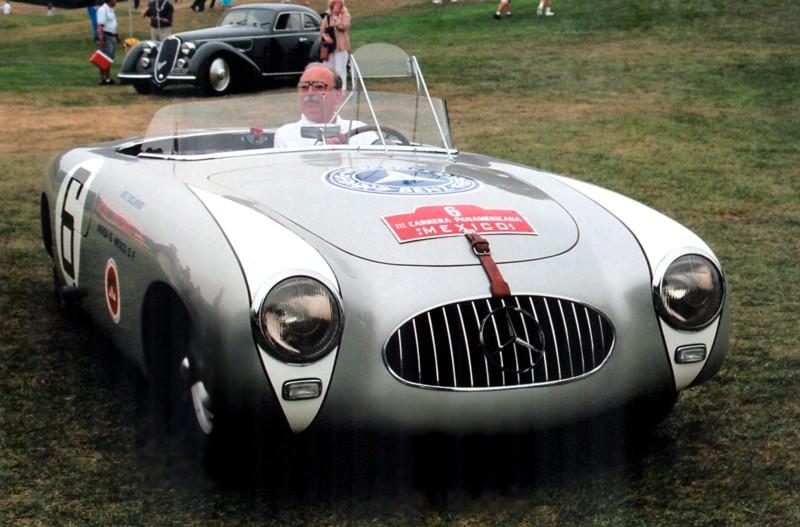
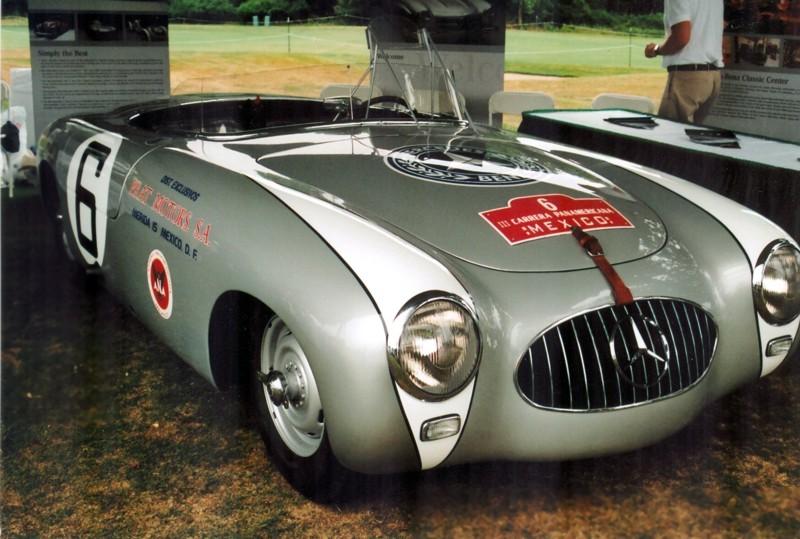
I know it is hard but try your best not to think the guy in the first picture is Himmler…. Nevertheless in my opinion the most beautiful spyder ever made. :good:
Attachments:
You must be logged in to view attached files.The Happy Canadian Scale Modeler!
September 13, 2017 at 3:23 am in reply to: Alfonso ‘Fon’ de Portago (1928-1957) Sports Cars Illustrated (Aug 1957) Portago Interview (1956) #3966Great article Bill! Thanks for scanning and posting! :yahoo:
P.S.-were the .jpg files too large to upload as attachments? I’m just curious as to the error… I believe the maximum file size should be 1200k.
The Happy Canadian Scale Modeler!
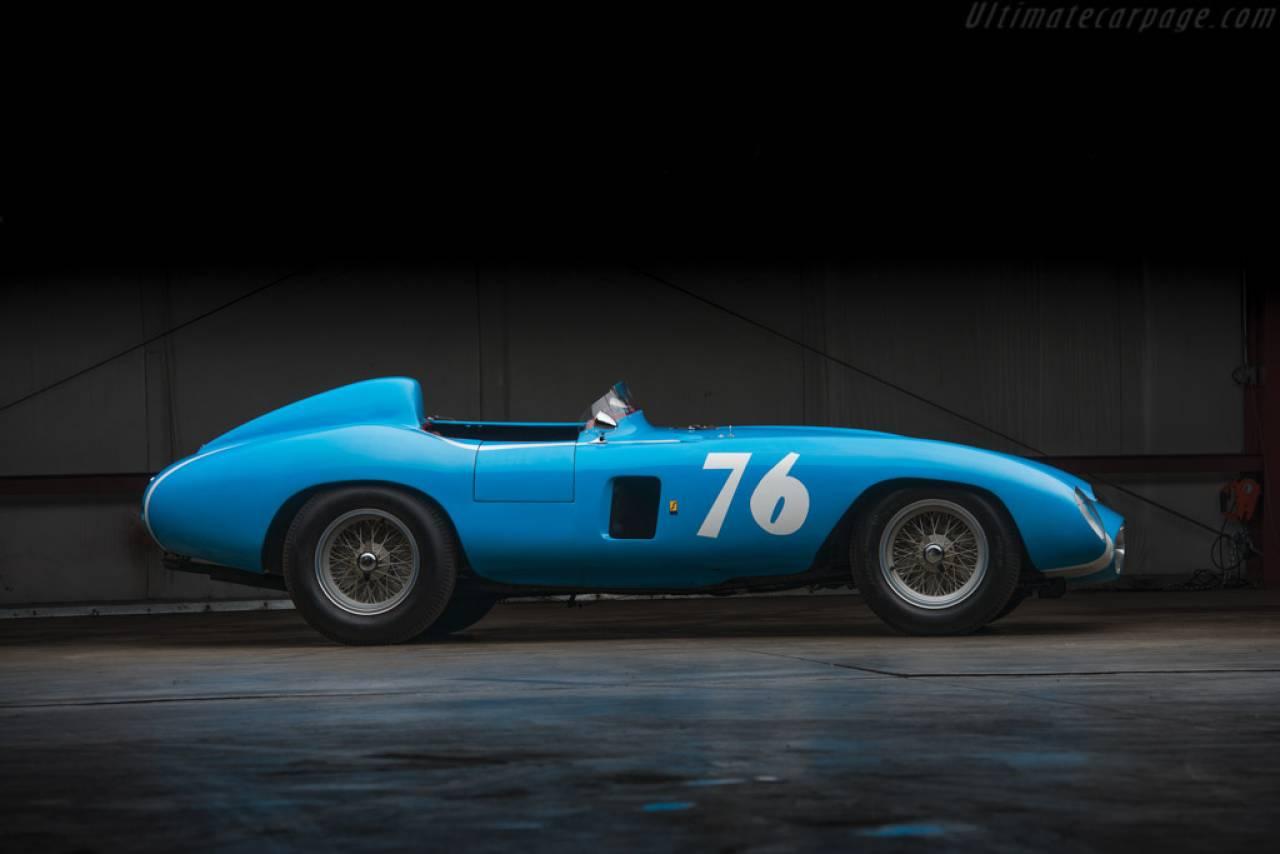 More info and pictures on the 1955 Ferrari 121 LM Scaglietti Spyder #76 here…
More info and pictures on the 1955 Ferrari 121 LM Scaglietti Spyder #76 here…The Happy Canadian Scale Modeler!
Some great cars to model too – Love the colour/livery of the Ferrari 121LM Spyder…
That’s Harry Schell to whom I believe they refer… see our 1:1 reference area and in particular the attachment therein… but you must be logged in to read that attachment…
Thanks for the link Bill! :good:
The Happy Canadian Scale Modeler!
Nice photos MiA! Were those cars being refueled in the lot behind the paddock?
The Happy Canadian Scale Modeler!
Cheers for the link Drew!
The Happy Canadian Scale Modeler!
I am negotiating plans this father’s day weekend with the girls and have included a trip to the track in one of my proposals… but the governing body has yet to make a decision… I must still stay tuned… I know that both you and Michael will be at the track so if I am there and throw a lawn dart I’ll hit someone I know… keep me posted… :unsure:
The Happy Canadian Scale Modeler!
Sounds good Bill. I’m not sure yet what we are doing on Saturday but if we can make it over I will definitely stop on by…
Art :unsure:
The Happy Canadian Scale Modeler!
Wow! Thanks Bill!
The Happy Canadian Scale Modeler!
R32 specific forum/subforum items such as race results will all remain in a subforum and R32 users will continue to be able to post in it if they wish to do so…
The Happy Canadian Scale Modeler!
That is neat. What kind of camera is it?
The Happy Canadian Scale Modeler!
February 2, 2017 at 9:24 am in reply to: Building in Upper and lower A arms and rear and front springs etc #2048Found some very flexible thin gauge wire at the dollar store – pack of 200 pieces for $1.50 – you can bend this stuff by hand or using tweezers – perfect for many things, even spring coils – I’m going to try to do suspension pieces on a car with it in time for Ringwood XVIII… stay tuned… :mail:
The Happy Canadian Scale Modeler!
Some of the other slide shows posted by the same chap from later years at the Targa have behind the paddock pictures including various transporters… and coincidentally the quality improves every year… Cheers!
The Happy Canadian Scale Modeler!
January 24, 2017 at 2:10 pm in reply to: Building in Upper and lower A arms and rear and front springs etc #1983Several ways to skin that cat and I’m still looking for the easiest one myself… good topic to bring up and timely from my point of view since the 804 I just raced in RWXVII is in need of some basic suspension detail still… I’ve got my eyes and ears on it…
The Happy Canadian Scale Modeler!
Very cool! Some great historical photos Michael! :good:
The Happy Canadian Scale Modeler!
That is a great point Michael – the DArt SC0118 early ’60s Grand Prix tire for the front (designated with an ‘F’) and the rears are perfect representations of the variance in sizes and those I plan to use for this model…
Cheers!
The Happy Canadian Scale Modeler!
Cheers!
After the girls hit the hay last night I had some free time to make that rack I mentioned earlier – tools from an Italeri set plus a broom I made myself (made a rake too but it came apart when I was attaching the completed rack to the side of the van)…
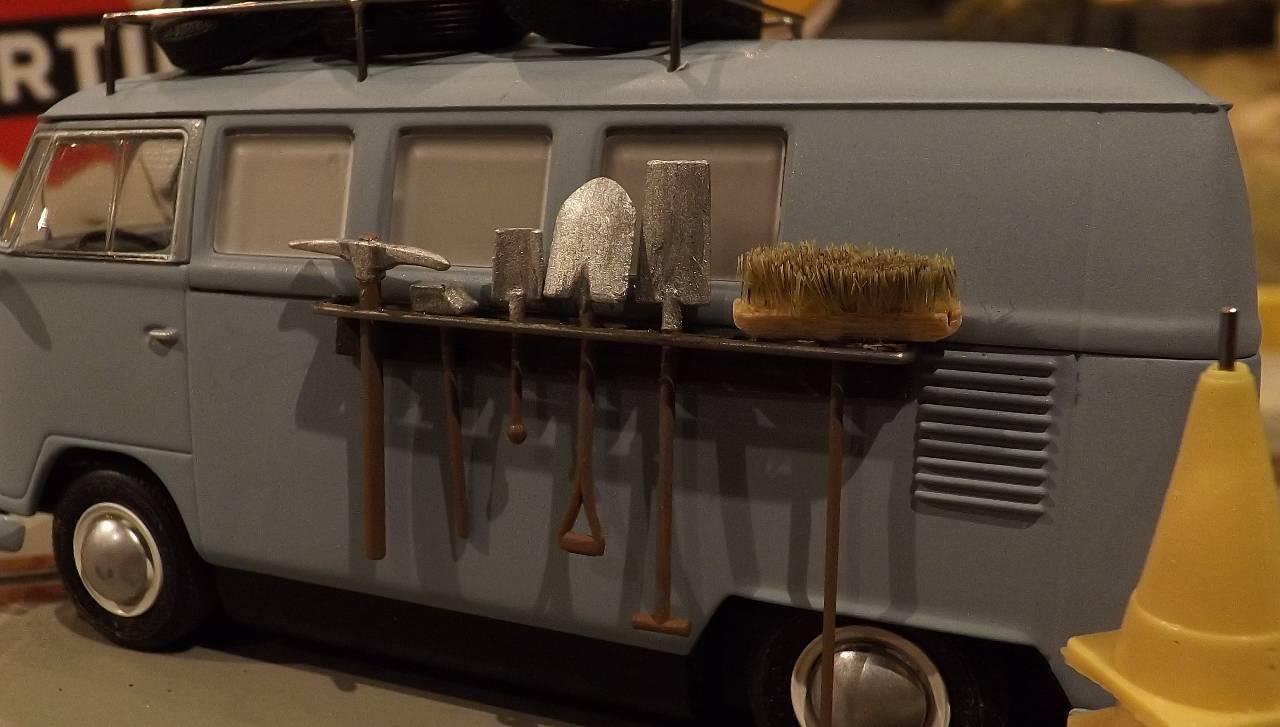
The Happy Canadian Scale Modeler!
Looks nice Dave.
The scratch32 crew were debating a class in the new year that might run vintage chassis & parts… in the end the consensus was that it might just be too expensive since very few had vintage 1/32 scale cars… but an interesting proposal nonetheless…
Keep ’em com’n!!!
Art
The Happy Canadian Scale Modeler!
Thanks for posting Bob.
The Happy Canadian Scale Modeler!
The links you ask for were always under our Slottrak thread…
http://scale-modeler.ca/forums/topic/slottrak-version-12-32/
Enjoy the rest of your camping weekend Frank!
Art :good:
The Happy Canadian Scale Modeler!
Thank You Bob.
Those of you who ordered your Matra Kits last week I’m including the decals which I’ve printed for you to try/use…
Cheers!
The Happy Canadian Scale Modeler!
A follow up for those of you with SCX Formula cars which have those bright and shiny ‘chrome’ parts such as wheels, mirrors, exhaust, motor/intake/transmission… Just drop them in your tub of Super Clean and after 1 hour you’ll get:
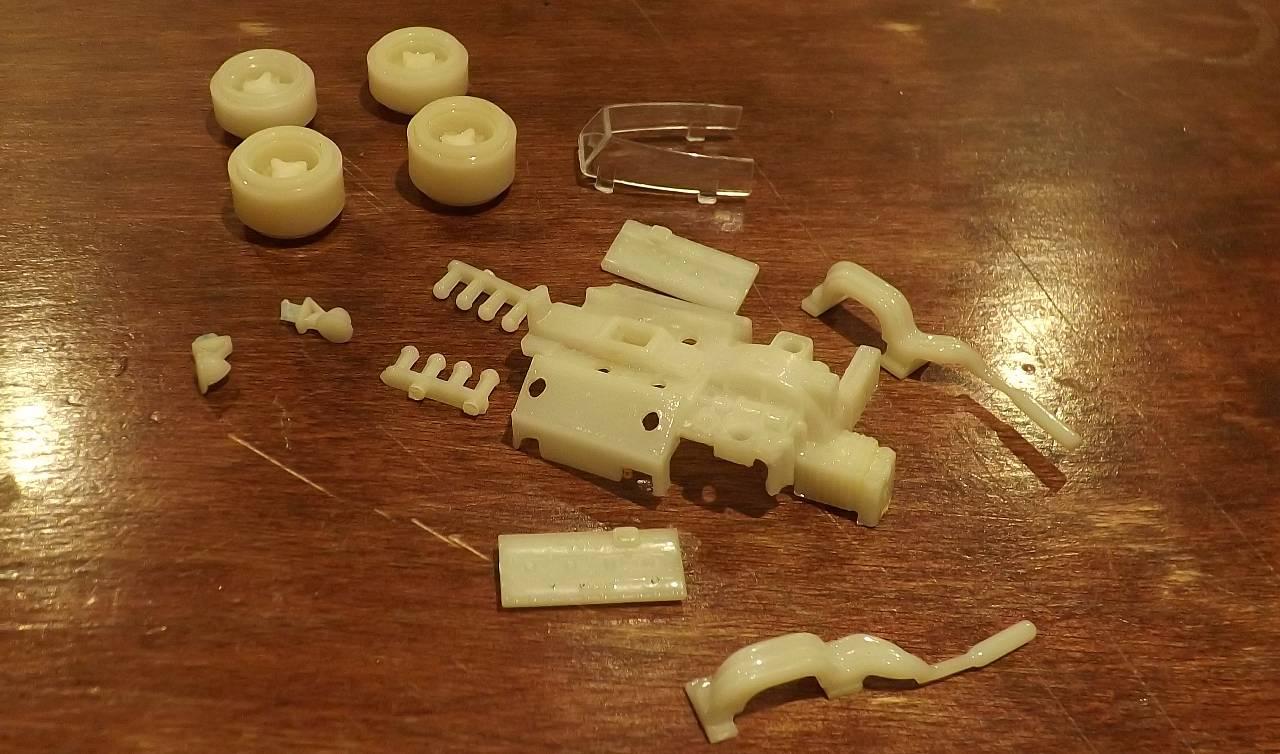
Rinse and dry and ready to prime… the above pieces are from a 1971 SCX Tyrrell which I will be re-assembling for the upcoming Ringwood. Removing the finish on these parts revealed original detail on the plastic pieces which I hope to preserve using my airbrush… also note the windscreen which was also dunked with the other parts – the ‘SCX’ tampo came off…
The wheels and mirrors will be replaced with more accurate pieces but it never hurts to have extra bits for other projects if the need arises…
Cheers! – Art :yahoo:
The Happy Canadian Scale Modeler!
I love how each number is a different size! Kevin loaned me a body kit to pop which is that car so this is a perfect reference for both driver detail and number…
Cheers! :good:
The Happy Canadian Scale Modeler!
It could be considered a long time coming. Unfortunately it is my understanding that some of the scheduled releases with this chassis were scrapped, nevertheless for our group the opportunity to upgrade components as promised could be very useful – especially for our LMP/GT class… lets see if someone can make a podium run with one of these chassis under a scaley body…
:good:
The Happy Canadian Scale Modeler!
After looking at the first picture I thought about the colour – beaut! Hard to nail down the real colours of those cars without confirmation from a reputable source!!!
Thank you Michael!
:good: :good: :good:
The Happy Canadian Scale Modeler!
Now that being said, everything is a crap shoot as most of us who’ve been in this hobby can attest to… so after soaking for more than three weeks here are the results just to confuse everyone a little more…
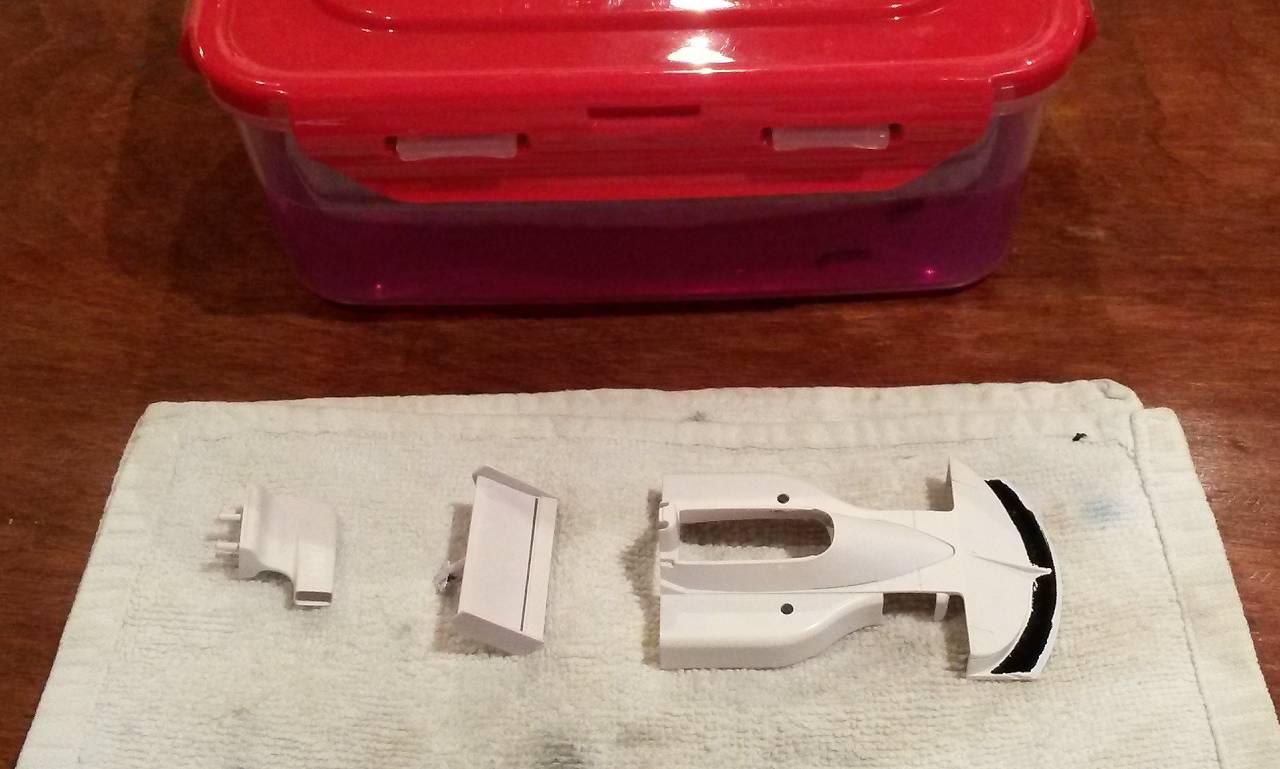
This was a Fly car body. The rear wing dissolved with the tampo and paint within days. It came out that way – BEAUT! The intake needed a little scrubbing and everything came off after the more than three week dunk. The body needed more scrubbing with my good toothbrush and almost all of it came off but for that black area on top of the wing skirt… so I’ll just prime over that….
…here’s the best news of all… the plastic components are rock solid and not compromised in any way at all (not like alcohol, turpentine or acetone)…
So… one car… three different results… just like the hobby itself…
Be patient, plan ahead, and enjoy! B-)
The Happy Canadian Scale Modeler!
If you google you might find something you like – that’s how I got this one which I printed on my inkjet printer. I believe Drew has more, some more retro than others – the problem is that some are unusable due to the low resolution they were initially scanned in… but since just about any logo is available on line if you are patient in an evening you can collect and combine them into clusters… I (and I believe Drew too) use a blank Word document to arrange/resize and store images prior to printing and this has worked really well for me so far… I would be happy to go through the process I use if you are interested – just let me know… :mail:
The Happy Canadian Scale Modeler!
Thank you for sharing the story and photo MiA! :good:
The Happy Canadian Scale Modeler!
Just to enlighten those not present during Ringwood XIII when we discussed the motor for the USRRC class of the CAN AM Thunder event it was agreed that we would limit the motor to any slow motor as in our sportscar class. This enables some cars to be raced in sportscars afterwards but most importantly keeps the speeds down to a more realistic pace.
The Happy Canadian Scale Modeler!
Somehow I never saw your post Frank until now – as with much of our rules and classes one would need to go back in time to see the logic that started the class. Hot rods were prompted by the availability of cheap Lindberg kits that flooded local dollar stores. Since they were very light and most had full interiors the FF050 motor made sense both from a price and performance view as well as to preserve the interior detail that came with the kits. This was a class that we all understood would need a scratch built chassis and so it became a favourite for those who wished to express their building, painting and creative side since there were really so few rules… we also weren’t forced to integrate existing larger motored cars since this was new class. Since the Vanski FF050 motors are no longer available we decided to restrict the motor just to the BWMS050 brand to keep things as fair as possible as well…
The S can although permitted and considered ‘equivalent’ for the sake of compatibility with other classes really is not, especially when dealing with heavier cars.
As someone used to always tell me, and to which I now subscribe, limit the grip (tires) and the power (motor) and you will always have the fairest racing possible.The Happy Canadian Scale Modeler!
Here are the numbers used for the DArthobbies CANAM Ferrari 612 Kit
Attachments:
You must be logged in to view attached files.The Happy Canadian Scale Modeler!
Hi Bob,
Thanks – you can link to anything you want on our website. If you use the img button it should paste in the html for the image and when you submit it will become visible to everyone…
ArtThe Happy Canadian Scale Modeler!
Hi Michael,
Are you referring to the R32 Quick Reference Spreadsheet on our rules page? To clarify, the FF050 and S-can references motor/can size/shape. Full RPM ranges can be found in both sizes/shapes. The slow motors are in the 14.4k – 15k RPM range regardless of can size. The larger can motors have a torque advantage but weigh more too.
The Happy Canadian Scale Modeler!
Hi Michael,
The slow motors such as found in our sportscar class allow both the slim FF050 motor (that is in your car for instance – Bill raced a King Cobra on Wednesday and that too requires an FF050 motor but to meet the R32 rules for sportscars he used a Vanski or BWMS050) and the S-can equivalent such as the BWA BWNC1 or the Ninco NC1 for chassis that accept them… check the R32 rules quick reference spreadsheet for an exhaustive list of slow motors allowed… hope this helps!
The Happy Canadian Scale Modeler!
I love that there is no guardrail or any barrier between the spectators and the runway/taxiway! The corvette looks fantastic too!
Cheers!
ArtThe Happy Canadian Scale Modeler!
Thanks Bill. Now I just need to get that M5A kit done…
Cheers!
ArtThe Happy Canadian Scale Modeler!
-
AuthorReplies
